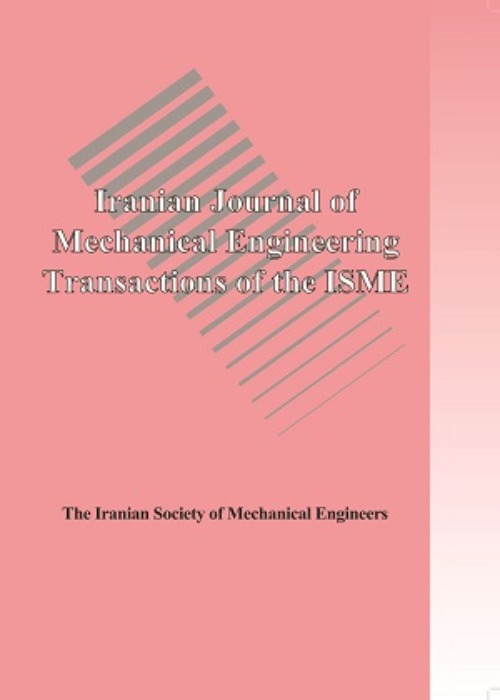فهرست مطالب
Iranian Journal of Mechanical Engineering Transactions of ISME
Volume:14 Issue: 2, Sep 2013
- تاریخ انتشار: 1392/08/30
- تعداد عناوین: 6
-
-
Pages 5-36In this paper to predict the critical conditions for onset of elastic-plastic wrinkling of flange of a two-layered circular blank during the deep-drawing process a closed-form semi analytical elastic-plastic solution using Tresca yield criterion alongwith deformation theory in plasticity with considernig the perfectly plastic behaviour of materials is presented. Simplifying the presented solution from two layered to one layered the results exactly agree with the previous work done by the authors.Keywords: flange wrinkling, closed, form semi, analytical elastic, plastic solution, two, layered circular blank, deep, drawing process
-
Pages 37-49In this paper, a new non-contact ultrasonic abrasive finishing mechanism is designed and fabricated. This mechanism combines the function of ultrasonic vibrations and the magnetic abrasive finishing (MAF) process. A permanent magnet is mounted on the horn.The magnet is vibrated at an ultrasonic frequency with piezoelectric actuators. In the created magnetic field the ferromagnetic abrasives form a flexible finishing tool. Ultrasonic energy and the relative motion between magnet and the workpiece are the stimulus of the steel grit abrasives for improving the surface quality. In order to take advantage of the cavitation collapse pressure, the components is immersed in water. The present work also studies the effect of parameters, i.e., finishing time and working gap on the surface roughness (Ra).Keywords: magnetic abrasive finishing, ultrasonic vibration, cavitation collapse, surface quality
-
Pages 50-72The available shear correction factors have mainly been developed for homogeneous isotropic plates and/or assuming that no shear tractions are imposed on the top and bottom surfaces of the plate. In the present research, a more general case of a circular functionally graded plate subjected to nonuniform normal and shear tractions at the top and bottom surfaces is considered. These non-uniform tractions may stem from the imposed non-uniform inclined tractions at the top surface and resting on the non-uniform Winkler-Pasternak elastic foundations. Instead of using the approximate numerical methods, the solutions are derived using a pure analytical method. In this regard, influences of the proposed analytical correction factor are evaluated on results of both the modal and the stress analyses.Keywords: shear correction factor, circular functionally graded plate, non, uniform tractions, vibration, stress, non, uniform elastic foundation
-
Pages 73-87This work presents thermoplastic analysis of FG rotating diskswith variable thickness and constant angular velocity. The solutions are obtained by variable material property (VMP) theory. In this theory, the domain is divided into some finite sub-domains in the radial direction, in which the properties are assumed to be constant and the form of the elastic response is used to solve elastic-plastic problems. The results are compared with the results obtained by the finite element analysis using ANSYS software. The results reveal that mentioned methods are in very good agreement in both thermoelastic and themroplastic states. Finally, the effect of various parameters including the thermal distribution and thickness profile on the stress behavior of disk are investigated.Keywords: functionally graded material, rotating disk, thermoplastic analysis, variable material property theory
-
Pages 88-97Biomechanical properties of soft tissue, such as liver, are important in modeling computer aided surgical procedures. Experimental evidences show that liver tissue is transversely isotropic. In this article, considering the liver tissue as an incompressible fiber-reinforced composite with one family of fibers, an exponential strain energy function (SEF) is proposed. The proposed SEF is based on a recently developed strain measure which is more consistent with the physics of deformation than the commonly used Green-Lagrange strain measure. To show the capabilities of the proposed SEF, comparison is done with the experimental data available in the literature. It is shown that the results of the proposed SEF is in a good agreement with the experimental data for both tensile and compression deformations.Keywords: Liver tissue, transversely isotropic hyperelasticity, strain energy function, consistent strain measure
-
Pages 98-109In this paper, the problem of calculating the stress intensity factor (SIF) for an orthotropic thick-walled cylinder with a small radial crack subject to internal pressure is considered. The crack is assumed to be an edge crack on the external radius of the cylinder. The stress intensity factor is calculated by superposition of an uncracked cylinder with uniform stress distribution and a cylinder with a small radial crack. To calculate the stress distribution in the small radial crack, basic assumptions of the Linear Elastic Theory have been used. Due to the small length of the crack, an average stress method with a proper weight function is then used to evaluate the stress intensity factor of the assumed crack problem. Simplifying the proposed formula for orthotropic cylinder to the isotropic one, the results are validated against data given in the literature search.Keywords: Small Radial Crack, Thick, walled Cylinder, Stress Intensity Factor, Orthotropic Cylinder


